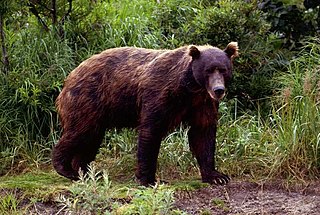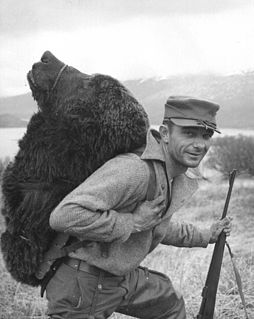
The brown bear is a bear species that is found across much of northern Eurasia and North America. In North America, the populations of brown bears are often called "grizzly bears". It is one of the largest living terrestrial members of the order Carnivora, rivalled in size only by its closest relative, the polar bear, which is much less variable in size and slightly larger on average.
According to the legend, the Golden Bear was a large golden Ursus arctos. Members of the Ursus arctos species can reach masses of 130–700 kilograms (290–1,540 lb). The grizzly bear and the Kodiak bear are North American subspecies of the brown bear.

The Kodiak bear, also known as the Kodiak brown bear, sometimes the "Alaskan brown bear", inhabits the islands of the Kodiak Archipelago in southwest Alaska. It is the largest recognized subspecies or population of the brown bear, and one of the two largest bears alive today, the other being the polar bear.

The names Atlas bear and African bear have been applied to an extinct population or populations of the brown bear in North Africa. The Cantabrian brown bear likely was introduced to Africa from Spain by the Romans who imported Iberian bears for spectacles.

The Tibetan bear or Tibetan blue bear is a subspecies of the brown bear found in the eastern Tibetan Plateau. It is also known as the Himalayan blue bear, Himalayan snow bear, Tibetan brown bear, or the horse bear. In Tibetan, it is known as Dom gyamuk.

The Eurasian brown bear is one of the most common subspecies of the brown bear, and is found in much of Eurasia. It is also known as the European brown bear, common brown bear, common bear, and colloquially by many other names. "The genetic diversity of present-day brown bears has been extensively studied over the years and appears to be geographically structured into five main clades based upon analysis of the mtDNA."

An ursid hybrid is an animal with parents from two different species or subspecies of the bear family (Ursidae). Species and subspecies of bear known to have produced offspring with another bear species or subspecies include black bears, grizzly bears and polar bears, all of which are members of the genus Ursus. Bears not included in Ursus, such as the giant panda, are expected to be unable to produce hybrids with other bears. Note all of the confirmed hybrids listed here have been in captivity, but suspected hybrids have been found in the wild.

The Syrian brown bear is a relatively small subspecies of brown bear native to the Middle East.
MacFarlane's bear is a proposed extinct species of bear that was found in Canada's Northwest Territories. In 1864, Inuit hunters shot and killed an enormous yellow-furred bear and gave the skin and skull to the Fort Anderson post manager and amateur naturalist Roderick MacFarlane of the Hudson's Bay Company. MacFarlane shipped the skin and skull to the Smithsonian Institution where they were placed in storage and soon forgotten. Eventually, Dr. Clinton Hart Merriam uncovered the remains, which he thought had been shot very far outside the brown bear's normal range, and concluded that it was not a brown bear at all. In 1918, he described the specimen as a new species and genus, Vetularctos inopinatus, calling it the "ancient unexpected bear."

The Himalayan brown bear, also known as the Himalayan red bear, isabelline bear or Dzu-Teh, is a subspecies of the brown bear and is known from northern Afghanistan, northern Pakistan, northern India, west China and Nepal. It is the largest mammal in the region, males reaching up to 2.2 m (7 ft) long while females are a little smaller. These bears are omnivorous and hibernate in a den during the winter. While the brown bear as a species is classified as Least Concern by the IUCN, this subspecies is highly endangered and populations are dwindling.

The Gobi bear (Ursus arctos gobiensis; known in Mongolian as the Mazalaai, is a subspecies of the brown bear that is found in the Gobi Desert of Mongolia. It is listed as critically endangered by the Mongolian Redbook of Endangered Species and by the Zoological Society of London. The population included only around 30 adults in 2009, and is separated by enough distance from other brown bear populations to achieve reproductive isolation.

The Kamchatka brown bear, also known as the "Far Eastern brown bear", is a subspecies of brown bear native to the Anadyrsky District, the Kamchatka Peninsula, Karaginskiy Island, the Kuril Islands, the coastal strip west of the Sea of Okhotsk southward to the Stanovoy Range, and the Shantar Islands in the Far East. Outside the former Soviet Union, the subspecies occurs in Saint Lawrence Island in the Bering sea. It is closely related to one clade of brown bears in Alaska and northwest North America, and is thought to be the ancestor of the Kodiak bear.

The Marsican brown bear, also known as the "Apennine brown bear", and in Italian and orso bruno marsicano, is a critically endangered population of the Eurasian brown bear, with a range restricted to the Abruzzo National Park, and the surrounding region in Italy. The Marsican brown bear is very similar to a regular brown bear with slight differences in its appearance and hibernation techniques.

Bear hunting is the act of hunting bears. Bears have been hunted since prehistoric times for their meat and fur. In modern times they have been favoured by big game hunters due to their size and ferocity. Bear hunting has a vast history throughout Europe and North America, and hunting practices have varied based on location and type of bear.

The East Siberian brown bear(Ursus arctos collaris) is a population or subspecies of brown bear which ranges from eastern Siberia, beginning at the Yenisei river north to the Arctic Circle, as far as Trans-Baikaliya, the Stanovoy Range, the Lena River, Kolyma and generally throughout Yakutia and the Altai Mountains. The subspecies is also present in northern Mongolia.

The Cantabrian brown bear or Iberian brown bear is a population of Eurasian brown bears living in the Cantabrian Mountains of Spain. On average, females weigh 85 kg (187 lb), but can reach a weight of 150 kg (330 lb). Males average 115 kg (254 lb), though they can weigh as much as 200 kg (440 lb). The bear measures between 1.6 and 2 m in length, and between 0.90 and 1 m at shoulder height. In Spain, it is known as the Oso pardo cantábrico and, more locally, in Asturias as Osu. It is timid and will avoid human contact whenever possible. The Cantabrian brown bear can live for around 25–30 years in the wild.

Sten Bergman was a Swedish zoologist, who visited Korea, Kamchatka, Papua New Guinea, and many other places.

The Ussuri brown bear, also known as the "Ezo bear" and the "black grizzly", is a subspecies of the brown bear or population of the Eurasian brown bear. One of the largest brown bears, a very large Ussuri brown bear may approach the Kodiak bear in size.

The Alaska Peninsula brown bear or "peninsular grizzly" is a colloquial nomenclature for a brown bear that lives in the coastal regions of southern Alaska, although according to other sources, it is a population of the mainland brown bear subspecies, or the Kodiak bear subspecies.
Formerly or currently considered subspecies or populations of brown bears have been listed as follows:
















